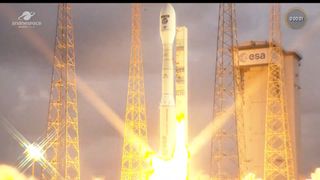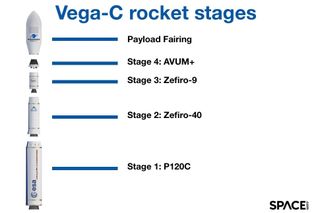Europe’s Vega-C rocket returned to flight Thursday (Dec. 5) with a worthwhile mission, two years after struggling a catastrophic failure.
Vega-C, which is operated by the French company Arianespace, launched the Copernicus Sentinel-1C Earth-observation satellite tv for pc television for computer tv for laptop computer on Thursday, lifting off from Kourou, French Guiana at 4:20 p.m. EST (2120 GMT; 6:20 p.m. native time).
The mission was initially alleged to fly on Wednesday (Dec. 4), nonetheless a mechanical draw back with the launch gantry nixed that try.

This was the third launch for the Vega-C, and its first since a failure inside the car’s second stage led to your complete lack of its final payload in December 2022.
Associated: Europe’s Vega C rocket fails on 2nd-ever mission, 2 satellites misplaced
Thursday’s mission lofted Sentinel-1C, a part of the European Union’s Copernicus Earth-observation program. The spacecraft is a substitute to finish a dual-satellite constellation with Sentinel-1A, following the gorgeous failure of its affiliate satellite tv for pc television for computer tv for laptop computer Sentinel-1B, which grew to develop into inoperable after experiencing a technical fault in 2022.
Sentinel-1C headed into orbit on the other side of Earth from Sentinel-1A, to permit the pair a whole view of the planet for high-resolution imagery.
Vega-C is a four-stage rocket that stands 115 ft (35 meters) tall. The primary three of the launch vehicle’s ranges are powered by solid-rocket propellant, with its fourth stage utilizing a liquid propellant for precision orbital insertions.
Vega-C’s first and second stage separations occurred on schedulde about 2.5 and 4.5 minutes after liftoff on Thursday, with its third stage following swimsuit merely after seven minutes into flight.

The rocket’s bigger stage flew Sentinel-1C to a sun-synchronous orbit at an altitude of about 435 miles (700 kilometers), deploying the satellite tv for pc television for computer tv for laptop computer as deliberate about one hour and 44 minutes after liftoff.
“It is a important launch,” acknowledged Giulio Ranzo, CEO of the Italian aerospace company Avio, all via a prelaunch media briefing, “important, due to we’ll elevate a flagship European satellite tv for pc television for computer tv for laptop computer of the Copernicus constellation with a flagship European launcher.”
Avio was contracted by the European Area Agency (ESA) as Vega-C’s main designer. Vega-C’s return to flight follows the debut launch of Europe’s bigger Ariane 6 rocket over the summer time season, in the long term filling the opening in launch vehicle wishes for smaller payloads and lessening Europe’s reliance on completely completely different launch suppliers.
“We’re very proud of having this efficiency made obtainable, notably to the European Worth, nonetheless normally, to all completely completely different authorities and non-government establishments inside Europe and overseas,” Ranzo acknowledged.
Sentinels-1A and C are outfitted with C-band artificial aperture radar (SAR) devices, which permit every to survey Earth for varied environmental observations. Sentinel-1C furthermore contains a new Automated Identification System (AIS), to be used by seafaring ships on Earth to keep away from collisions after they’re out of vary of land-based radar methods.
The overall of information collected as part of the Sentinel-1 program is in depth and ongoing, and stands to be vastly aided by the addition of Sentinel-1C.
“150,000 merchandise based completely on Sentinel-1 information are revealed and made obtainable to shoppers, and provided that starting of the operations of the Sentinel-1, we’ve obtained generated over 30 petabytes of information and bigger than 14 million merchandise have been made obtainable,” Christoph Kautz, the European Worth’s Director for satellite tv for pc television for computer tv for laptop computer navigation and Earth assertion for the Directorate-Common for Security Enterprise and Area (DG DEFIS), acknowledged within the midst of the current prelaunch briefing.
Vega-C’s two-year journey as soon as extra to the launchpad required a design and manufacturing change to the car’s second-stage rocket engine nozzle. Now as soon as extra in operation, Ranzo says the rocket has about 15 launches on its backlog to finish.
The hiatus in Vega-C from the rocket launch enviornment hasn’t slowed ESA’s enhancements in route of enchancment. The realm agency has already begun designing an upgraded model of Vega-C, the Vega-E, based completely on a mannequin new liquid oxygen (LOX)-methane engine, the M-10, for its bigger stage. The M-10 may be being developed by Avio, which plans to signal implementation contracts with ESA earlier than the tip of the 12 months, in keeping with ESA’s Director of Area Transportation Toni Tolker-Nielsen.
Sentinel-1C’s partnership with its predecessor Sentinel-1A could also be short-lived, on account of the constellation is receiving its non-public upgrades. The ageing Sentinel-1A, which launched in 2014, is about to get modified by Sentinel-1D subsequent 12 months, at present scheduled to launch in September.
Editor’s uncover: This story was up to date at 3:20 p.m. ET on Dec. 4 with information of the launch delay and the mannequin new goal of Dec. 5. It was up to date as quickly as further at 4:40 p.m. ET on Dec. 5 with information of an on-time liftoff, then as quickly as further at 6:05 p.m. ET with information of worthwhile satellite tv for pc television for computer tv for laptop computer deployment.
